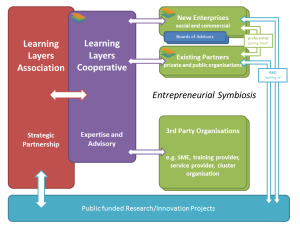Start of year 2016 with Learning Layers – Part 4: Working with the LL exploitation model
In my three previous blogs I wrote a series of reports on the ‘start of the year 2016′ meetings in with our EU-funded Learning Layers (LL) project. In the first post I reported on the meetings of the ‘local’ LL teams of ITB, Pont, and Bau-ABC (in Bremen and Rostrup). In the third post summarised a video conference that discussed a set of themes for our next consortium meeting in Innsbruck (2.2.-5.2.2016). In this fourth post I report on the video conference of the ITB team with our LL colleagues Gilbert Peffer and Raymond Elferink on the Exploitation model for the LL project.
In my previous blog I had already given the following characterisation of the work of Gilbert and Raymond with this model:
“… Gilbert Peffer and Raymond Elferink have organised bilateral or trilateral conversations with LL partners to create a comprehensive model of exploitation activities. The aim is to compress the pictures given by different exploitation stories and to create more transparency between different initiatives. In this way different partners can find their roles and possibilities in a joint group picture. And with the help of this model the partners can trace the changes from current project partnership to future partnerships (in follow-up projects) or future business relations (in commercial exploitation activities).”
Below I have copied the current draft of the Exploitation model:
In our discussion in the video conference and after it we started a process of sensemaking, how to fit our exploitation initiatives into this landscape and how to grasp the zones of possible activities that we had not yet thought of. Here I try to interpret different areas of the exploitation model from this perspective:
a) The (peripheral) support area
Two fields in the model can be characterised as a (peripheral) support area for emerging follow-up activities with different intensity of support measures:
a1) “The Learning Layers Association” can be seen as a light-weight form to continue the cooperation across project consortium as an interest group that promotes the tools and ideas of the LL project in new contexts. For this purpose the interest group cam organise joint search conferences or workshops with new potential application partners. (Here the contacts of the LL partners at OEB with the UNHCR might serve as a clue for looking partners for such search conferences.)
a2) “The Learning Layers Cooperative” can be seen as a more committed service alliance – grouping of LL partners that are ready to support new initiatives with technical advice and facilitation in project creation. (Such cooperation has already been practiced between different partners to give shape for spin-off projects.)
b) The Research & Development area
The importance of this area is obvious, since we need to continue with R&D projects to develop the products and services of the LL project to more mature stage. Here we need to have a more differentiated look at the R&D agendas to pursue. Without going into details of specific initiatives it is worth taking into consideration the following type of R&D activities:
b1) Comprehensive follow-up projects (Horizon 2020 etc) that focus on further development of integrative toolsets for/with specific application partners – engaging different kinds of expertise from the LL project but linking it to new contexts.
b2) Specific R&D projects (e.g. within cluster initiatives) that link the further development of LL tools and similar toolsets to technical innovation programs.
Here the model emphasises that the R&D area needs to involve the application partners and the commercial partners as well (in order to take the products and services further).
c) The commercial exploitation area
We have already become aware of the fact that software development in research context may have different working patterns/perspectives than software development as customer service. This is reflected in the ‘commercial exploitation area’ by differentiating between three kinds of organisational entities:
c1) New enterprises (social/commercial) that dedicate themselves on further development of LL tools, software and services as their core business.
c2) Existing partners (private/public organisations) that continue working on the basis of their business models or institutional frameworks.
Here the model suggests that if new entreprises emerge, preferential ‘giving back’ partnership relations should be agreed in the founding processes. (Also, new enterprises need advisory boards.)
c3) Third party organisations (SMEs, training providers, service providers, cluster organisations) need to be involved with appropriate partnership agreements.
Altogether, the model was shaped with an idea of an “Entrepreneurial symbiosis’. I am looking forward to our next phase of working with this model in our project consortium meeting in Innsbruck.
More blogs to come …

